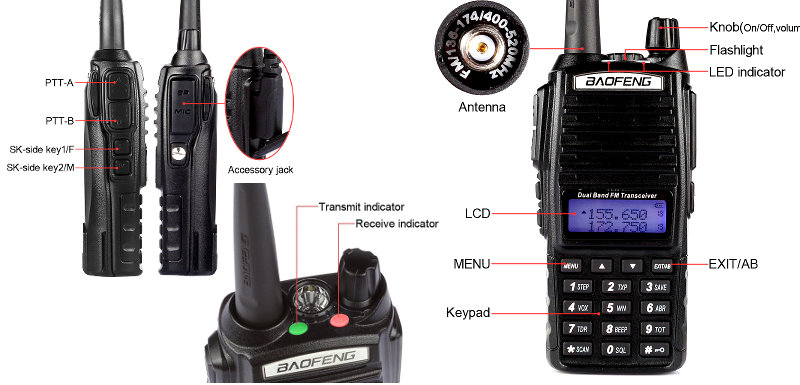Baofeng UV-82
These are an economical Dual Band UHF/VHF Amateur Radio. The UV-82 series of radios feature a rocking Push-to-Talk button which allows you to transmit on two frequencies depending on how you push the button. By pressing up you can transmit on "Frequency A" and by pushing down you can transmit on "Frequency B".
Improvements over the Baofeng UV-5R include a louder speaker (1 watt), rugged case, larger buttons, and more powerful control processor. The radio barrows from design qualities of commercial Part 90 radios. The battery compartment has better contacts to prevent issues common with older Baofeng radios during off when the battery contact became intermittent.
Manufacture or distributor name variations include: Baofeng Pofung UV82 UV82X
There are variations of the UV-82. Some are listed here:
- Baofeng UV-82 - Dual Band VHF/UHF TX 136 - 174MHz, 400 - 520MHz for ham / amateur radio
- Baofeng UV-82C - Dual Band VHF/UHF TX 136 - 174MHz, 400 - 520MHz, VFO disabled, C "Commercial" claims to be Part 90 type accepted
- Baofeng UV-82L - Dual Band VHF TX TX 136 - 174MHz, 220 - 260MHz for ham / amateur radio (possibly a UHF variant also available)
- Baofeng UV-82X - Dual Band VHF TX TX 136 - 174MHz, 220 - 260MHz for ham / amateur radio (unknown if exactly same as 82L)
- Baofeng UV-82HP - Dual Band Tri-Power variation with different firmware, and 3 Power Levels (1, 5, 7 watt). Uses the same 1800mAh Battery and the UV-82 CH-8 charger as other UV-82 models. Same physical appearance as other UV-82 units.
UV-82 models (82, 82L, 82C and 82X) look the same and use the same batteries, chargers, and accessories with the exception of the antenna which is band specific.
The UV-82C disables VFO operation. Programming is done with software. It is possible to enable VFO with software.
There are UV-82L models that are dual band VHF/UHF TX 136 - 174MHz, 400 - 520MHz which appear to be identical to the UV-82 model. Chinese model designations are inconsistent. This is typical with Baofeng Pofung import radios.
UV-82DX/82HXz, seem to be variations of the UV-82HP (unconfirmed), while GT-5TP, UV-8R, UV-82WP, UV-5RWP are related however it is unknown what physical and firmware differences they have as these versions have been reported to exist but may not even be original Baofeng. Once again, ambiguous version variations and copy cat manufacturing is all too common from these Chinese radios.
- NOTE: Baofeng UV-82 V2+ Tri-Power is Not the same as the UV-82 line. It has an entirely different appearance and firmware.
- 128 Channels at 25KHz (wide band)12.5KHz (narrow band)
- Sensitivity ≤0.25μV (wide band) ≤0.35μV (narrow band)
- Operates at 7.4V DC ±20% from a 1800mAh
- Frequency step selection of 2.5, 5, 6.25, 10, 12.5, 20, 25, 30 and 50KHz
- Relative xmit power depends on model, standard is 5W / 1W or 2W on 220
- Audio Power Output 1000mW/10% (1 Watt)
- CHIRP compatible
Review
They are not manufactured to the standards of Kenwood, Icom, or Yaesu, however, for a fraction of the price they have a good place in the market for those on a budget. This is especially useful for a small business wishing to purchase quantities. The battery connect improvement should make them far more reliable than the UV5r. The ability to set them to channel mode only makes them useful for business.
The Baofeng UV-82L model was discontinued due to strong harmonics. When used on 1.25 meter the radio emitted on 70cm also (splatter) beyond acceptable limits. Also, the menu was flawed as the Chinese labelled 1.25-meter operation as UHF, which is incorrect as the band is within the VHF spectrum.
Program
Manual programming w/o software:
The radio must be in VFO mode to save frequency into channel memory, Press/Hold MENU button during Power ON. Pressing [MENU] enters settings selection menu, pressing [MENU] again enters specific setting, pressing [MENU] again SAVES selection setting. Pressing [EXIT/AB] at any time in menu layers exits without changing setting.
Channel Memory Entry
- Ensure VFO A is active (upper freq on display)
- Disable Dual Watch, menu item #7 (TDR)
- use keypad and enter frequency
- if needed set CTCSS, menu item #13 (T-CTCS) or transmit tone
- set repeater offset, menu item #26
- set repeater offset direction or disable, menu item #25 (SFT-D)
- select memory channel for save, menu item #27 (MEM-CH)
Program via software using CHIRP:
Supported by CHIRP: UV-82/82L/82X, includes the GT-5, UV-9R, UV-82C, UV-82HP/82DX/82HXz, GT-5TP, UV-8R, UV-82WP, UV-5RWP variants using same selection. Not all functionality is supported on all radio these models. Can use most of the same Prolific / FTDI programming cables as used for the UV-5R. The UV-82 is a VHF/UHF radio. The UV-82X is a VHF/220 radio. There is a single byte that CHIRP looks at to try to determine which model. The VHF/UHF radio has an odd numbered firmware version, where the VHF/220 model has and even numbered firmware version. The recent versions of CHIRP have a menu selection for the UV-82 model specifically.
Technical
N822411 is the non-US market firmware.
